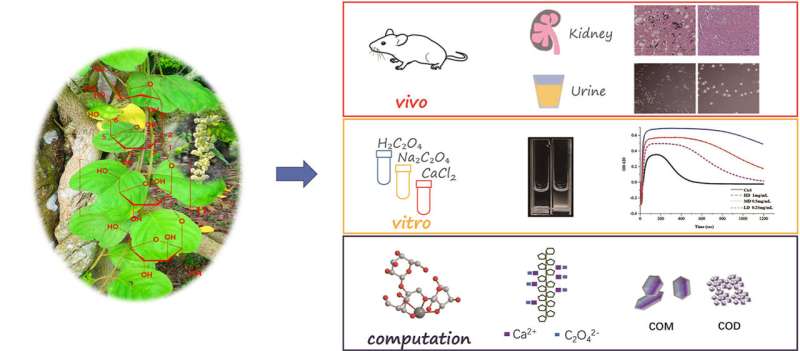
In the Dai minority region of China, the Aspidopterys obcordata (Hei Gai Guan) has been used as a fork medicine for the treatment of urinary tract infections, cystitis, and urinary tract stones. Previous studies showed that the Aspidopterys obcordata fructo oligosaccharide (AOFOS) from Hei Gai Guan has inhibitory effects on the growth of calcium oxalate crystals of the kidney stones (also known as urolithiasis). However, the effects of plant polysaccharides on the prevention and treatment of kidney stones are poorly understood.
In a study published in Journal of Ethnopharmacology, researchers from the Xishuangbanna Tropical Botanical Garden of the Chinese Academy of Sciences investigated the effect of inulin-type AOFOS from Aspidopterys obcordata on urinary calcium oxalate crystals to explore its efficacy and mechanism in treating kidney stones in rats.
The researchers first developed a rat kidney stone model and examined the transport kinetics and efficacy of AOFOS in living rats. By combining crystallization experiments with density functional theory calculations, they then investigated the relationship between polysaccharides and calcium oxalate crystals.
They found that the inulin-type AOFOS extracted from Aspidopterys obcordata had inhibitory effects on kidney stones in rat models, and the polysaccharide was transported to the urinary system. Low dose of AOFOS had a good therapeutic effect on kidney stones in rats, but the therapeutic effect of medium and high dose of polysaccharide was weak.
They then examined the anti-stone ability of rat urine and polysaccharide content under different treatment conditions. Under acidic conditions, calcium oxalate crystal formation was slower and tended to form monohydrate crystals. However, with increasing pH, the rate of crystal formation increased, resulting in crystals with various shapes and larger volumes, including calcium oxalate dihydrate (COD) crystal formation.
The researchers further found that the accumulation of polysaccharides was inhibited by controlling their crystallization and modulating the properties of calcium ions and oxalate in urine. This effectively prevented kidney stone formation in the rats.
“Our study provides valuable insights into the potential therapeutic use of the polysaccharide AOFOS extracted from Aspidopterys obcordata in the treatment of kidney stone formation,” said Xu Youkai of XTBG.
More information:
Peng Sun et al, Targeting urinary calcium oxalate crystallization with inulin-type AOFOS from Aspidopterys obcordata Hemsl. for the management of rat urolithiasis, Journal of Ethnopharmacology (2024). DOI: 10.1016/j.jep.2024.118149
Citation:
Chinese herb Aspidopterys obcordata shows potential in treating kidney stones (2024, May 8)
chinese-herb-aspidopterys-obcordata-potential.html
.
. The content is provided for information purposes only.
